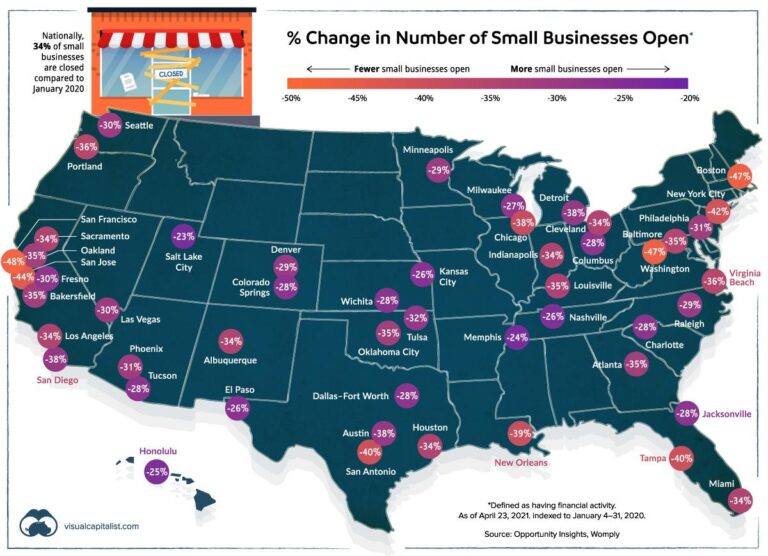Uneven Recovery of Small Businesses in the U.S.: Challenges, Trends, and Strategic Solutions
Regional Variations in Small Business Revival Across America
As the U.S. economy strives to regain momentum post-pandemic, the revival of small businesses serves as a vital barometer of progress. Yet, recovery rates vary dramatically depending on geographic location. Major metropolitan areas such as San Francisco and New York City continue to face hurdles, including high commercial vacancy rates and altered consumer habits that dampen entrepreneurial activity. Conversely, many communities in the Midwest and Southern states demonstrate remarkable resilience, buoyed by grassroots initiatives and strong local commerce networks. These regional differences reflect a complex mix of economic infrastructure, social dynamics, and policy environments shaping recovery paths.
Several critical elements influence these geographic disparities:
- Capital Availability: Areas with enhanced access to financial resources experience quicker business reopenings and growth.
- Technological Connectivity: Regions with advanced digital infrastructure enable businesses to pivot effectively to hybrid or online models.
- Governmental Support: Local and state policies offering tax breaks, grants, and promotional efforts significantly impact recovery speed.
| City | Percentage of Businesses Reopened | Average Revenue Recovery (%) | Level of Local Support |
|---|---|---|---|
| Chicago | 78% | 65% | High |
| Atlanta | 84% | 72% | Medium |
| Portland | 69% | 58% | Low |
| Dallas | 87% | 76% | High |
Industry-Specific Obstacles Shaping Post-Pandemic Growth
Recovery rates also diverge significantly across different sectors. While technology and e-commerce industries have surged ahead, traditional service sectors such as hospitality and retail continue to face persistent challenges. Labor shortages, supply chain interruptions, and fluctuating consumer confidence have increased operational costs and complicated efforts to regain pre-pandemic performance levels. Additionally, ongoing regulatory changes and health protocols add layers of uncertainty to business planning and investment decisions.
Key sectoral challenges include:
- Workforce Availability: Service industries report approximately 20% greater difficulty in rehiring qualified staff compared to manufacturing.
- Funding Gaps: Arts and recreation businesses often struggle to secure necessary capital, delaying modernization and expansion.
- Consumer Behavior Shifts: Travel and entertainment sectors remain vulnerable to changes in public sentiment and health concerns.
| Industry | Recovery Rate (%) | Main Challenge |
|---|---|---|
| Technology | 85% | Supply Chain Disruptions |
| Hospitality | 45% | Labor Shortages |
| Retail | 60% | Changing Consumer Preferences |
| Arts & Recreation | 35% | Limited Access to Capital |
Government Initiatives and Policy Measures Supporting Small Business Stability
In response to economic disruptions, federal and state governments have implemented targeted programs to assist vulnerable small businesses. Initiatives like the Paycheck Protection Program (PPP) and Economic Injury Disaster Loans (EIDL) have provided essential liquidity, helping many enterprises maintain payroll and cover expenses during critical periods. Nevertheless, uneven distribution of these resources remains a concern, often influenced by factors such as location, industry, and the ability to navigate complex application procedures.
Important policy tools influencing recovery include:
- Sector-specific grants and loan programs tailored to unique business needs
- Tax incentives designed to promote reinvestment and workforce expansion
- Regulatory relief measures that reduce compliance burdens during recovery
- Support for digital transformation and technical assistance for small enterprises
| Policy Program | Targeted Industry | Recovery Impact |
|---|---|---|
| PPP Loan Forgiveness | Retail & Hospitality | High retention of employees |
| Extended Tax Credits | Manufacturing | Boosted capital investments |
| Digital Innovation Grants | Small Service Providers | Enhanced online presence and sales |
Recommendations for Building an Inclusive and Sustainable Economic Recovery
To cultivate a resilient and equitable economic resurgence, it is imperative that policymakers and stakeholders implement customized support frameworks addressing the distinct challenges faced by small businesses, especially those in underserved communities. Expanding affordable financing options, improving digital infrastructure, and incentivizing innovation through targeted funding are essential steps. Moreover, fostering partnerships between public institutions and private enterprises can strengthen local economies by facilitating resource sharing and knowledge exchange. Investing in workforce development aligned with evolving market demands will further enhance labor market adaptability.
Embedding sustainability into recovery efforts is equally critical. Encouraging the adoption of eco-friendly technologies and energy-efficient practices through tax incentives and educational programs can reduce environmental impact while lowering operational costs over time. The table below outlines strategic priorities to drive inclusive and sustainable growth:
| Focus Area | Recommended Strategy | Anticipated Benefit |
|---|---|---|
| Financial Accessibility | Broaden microloan availability and simplify grant applications | Improved liquidity and business expansion in marginalized regions |
| Digital Advancement | Invest in broadband infrastructure and e-commerce skill-building | Expanded market reach and operational efficiency |
| Environmental Innovation | Offer tax credits for sustainable technology adoption | Lower carbon emissions and long-term cost reductions |
| Workforce Enhancement | Develop sector-specific training programs | Increased employment and labor market flexibility |
Conclusion: Navigating the Path Forward
As the United States continues to recover from the pandemic’s economic fallout, the uneven rebound of small businesses remains a pressing concern. Insights from the World Economic Forum emphasize the multifaceted factors influencing which enterprises thrive and which lag behind. Addressing these disparities through targeted support, inclusive policies, and sustainable practices is crucial not only for the survival of small businesses but also for fostering a resilient and equitable national economy in the years ahead.




